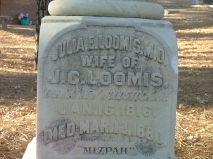In the mid-1800s, people needed determination and patience
to travel from one side of the country to the other. Stagecoaches ran on a
weekly or bi-weekly schedule. A trip from St Louis to San Francisco involved
about 25 days of travel. The coaches were drawn by six horses and stops were
made every 12 miles for fresh teams. Depending on the terrain, coaches covered
between 5 and 12 miles per day—running day and night. Passengers were grateful
to get hot coffee, biscuits and jerky at these stops; on rare occasions, hot
meals were available.
True, the Transcontinental Railroad was completed in the
summer of 1869 but that line served a route of the most-populous cities. How was
someone, like my character Ciara Morrissey raised on the East Coast, to travel
to an out-of-the-way location like Bull City, in northern Wyoming Territory? The
Union Pacific Railroad ran through southern Wyoming and from Cheyenne a
small-sized coach, most likely a Concord coach (built with sturdy braces for a
more comfortable ride), ran a north/south route.
The suggested items to travel with would have filled a large
satchel or three. In addition to their clothing, passengers were admonished to
pack 6 pair of thick socks, woolen underdrawers, blankets—one in summer and two
in winter, 3-4 towels, heavy overcoat, light coat, hat and their choice of
pistol or knife for personal protection. Imagine being a well-bred lady from an
upstanding Massachusetts family reading that list.
Once she got inside the stagecoach, she would have had her
choice of window or middle position (approximately 15” in width) on either a
forward or backward-facing bench seat. As she set out on her journey, she could
read the rules about men forgoing swearing and smoking in a lady’s presence,
but tobacco chewing was allowed, as long as the chewer spat downwind. I would hope so. Or if the person
(presumed to be a male) couldn’t refrain from drinking alcohol, then he must
pass the bottle around. Yum. Snoring
loudly or using another passenger’s shoulder as a pillow were frowned upon.
Improper advances toward a woman could get the male kicked off the stagecoach
in the middle of nowhere. Forbidden topics of conversation were stagecoach
robberies and Indian uprisings. Sounds like
a smart rule. Shooting at wildlife (Wyoming had a huge population of
pronghorn antelope) was prohibited. Passengers were encouraged not to jump from
the stage in case of runaway horses so as not to be left victim to the weather,
hostile Indians or hungry coyotes.
Like I mentioned, Ciara had a purpose and she looked at all
these strictures as part of her great adventure. She’d made a deathbed promise
to her mother to seek out the father she didn’t remember, and Bull City was his
last known location. Not only does she have the “excitement” of the trip, her
stage is attacked, a passenger dragged out and the driver shot. She arrives at
her destination, hands locked tight around the leather reins. That’s the first
time Sheriff Quinn Riley sees her and the story of Dreams of Gold begins. Amazon buy link
As a child, Linda Carroll-Bradd was often found lying on her bed reading
about characters having exciting adventures in places far away. In later years,
she started writing romances and achieved her first publication--a confession
story. Now Linda writes heartwarming contemporary and historical stories with a
touch of humor. Read more about her publications at her website or sign-up for her newsletter (inaugural issue this fall)














%2B2.jpg)
.jpg)























